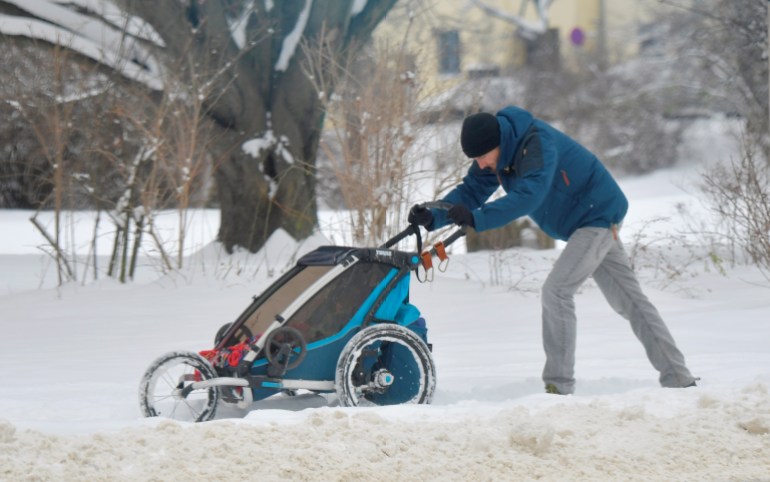Demographic shifts: How will COVID impact European populations?
Excess deaths are an immediate effect, but concerns are rising about the lasting impact of job losses on birth rates.

More than a year after the novel coronavirus first reached Europe, which has to date recorded more than 775,000 deaths and 34 million confirmed cases, the deadly pandemic is far from over.
Governments across the continent are scrambling to deal with unprecedented health crises as hospitals continue to be overwhelmed with large numbers of patients.
Keep reading
list of 4 itemsRussia: Population shrinks for first time in 15 years
‘Unprecedented exodus’: Why are migrant workers leaving the UK?
‘Demographic crisis’: Poland population shrinking under pandemic
Mass vaccination campaigns are facing issues and the threat of virus mutations is rising.
But major demographic shifts in the region as a result of COVID-19, which go beyond the primary health impact, are already beginning and experts say some of these societal changes could have long-term effects.
Gunnar Andersson, a professor in demography and head of the Stockholm University Demography Unit, said that in the short term the most obvious consequence of the pandemic has been a spike in deaths – in many cases, 10 or more percent higher in 2020 than the year before.
“Of course, mortality rates have risen because of COVID. But the long term impacts of this rise are probably not enormous,” he said, adding that most who died were older or “the most frail” in society.
Instead, Andersson pointed to the longer-lasting effect that the pandemic is likely to have on the fertility rates of nations across Europe, which he says could dip further over the next years, as it did in the aftermath of the 2008 financial crisis.
While some developing countries are registering the beginnings of a baby boom, due in part to reduced funding for and access to contraceptives and family planning services, Europe is facing a birth slump as the effect of lockdowns are felt.
“We can see that in most cases fertility rates in Europe have already changed,” he explained. “Some claimed if people were at home there would be more babies. But that is not the case. They are dropping.”

‘The pandemic doesn’t breed confidence’
Uncertainty over the future brought about by the pandemic as well as the looming labour market crisis, the shift to digital interaction and cuts in government spending, are at the heart of this.
In short, people could be less likely to make serious life decisions in times of crisis.
“The pandemic doesn’t breed confidence about the future and it has created a more fragile labour market,” said Andersson. “People are more likely to want to hold off until we have returned to normality.”
Preliminary numbers are bearing that out.
According to a study carried out by Italian researchers, which analysed data from Italy, France, Germany, Spain and UK, many people abandoned their plans to have children during the strict lockdown measures implemented in March and April last year.
“Historically, economic crises have never been the preferred period for a couple to decide to have a baby,” the researchers wrote in the study, published by the open-access site SocArXiv.
“The millions of jobs lost in [those] circumstances, even when a couple is not directly affected, create a climate of great uncertainty, which depresses family projects. Therefore, we may expect the economic crisis due to the COVID-19 emergency to produce similar demographic outcomes.”
Poland, a country of about 38 million people, saw 357,400 births last year, a 15-year low.
Births in Italy in December fell by 21.6 percent, according to figures released by statistics agency ISTAT.
The German statistics office said 2020 was the first year since 2011 that the national population did not grow, “due to lower net immigration, higher mortality and an expected slightly smaller number of births compared with the previous year”.
Demographers believe mortality rates could return to their previous levels within a matter of years, but falling birth rates – which had already begun to decline in the face of high youth unemployment, the digital revolution and housing market crises – could have serious long-term effects.
“Once the pandemic is over mortality trends will improve, whereas the numbers of births might be depressed for many more years to come,” said Tomas Sobotka, head of the Vienna Institute of Demography’s research group on European demography. “COVID has accelerated these things that were already unfolding.”
But these shifts are likely to be felt differently across the continent, given the varying health impact of the pandemic, government policies, and economic recovery.
Recent data from Finland, for example, bucked the trend and indicated a slight increase in fertility rates in recent months.
“There has been very low birth rates and outward migration in southeastern Europe, places like Bulgaria and Romania,” said Sobotka. “Very low fertility rates are the story of southern Europe. But in the Nordic countries, it’s different – there was already inward migration and population declines are much less serious, at least in the long term.”
For Sobotka, migration and urbanisation are other factors that are likely to be affected – but due to limited data and uncertainty, the years ahead are difficult to predict.
“Many big cities like Vienna, London and Zurich were experiencing dynamic population growth despite low fertility, because this is where jobs were,” he said. “Now that internal and international migration is limited that could change. But it’s difficult to speculate.”
According to a study by the United Kingdom’s Economic Statistics Centre of Excellence, as many as 1.3 million people born abroad left the UK between July 2019 and September 2020.
Another study published last month estimated that nearly 700,000 people left London in the last year, with many expatriates reacting to Brexit.
Research by the British engineering firm Arup also found that about 20 percent of Paris residents and 10 percent of inhabitants of Madrid, Milan and Berlin left at some point last year.

‘A big setback for gender equality’
Ridhi Kashyap, associate professor of social demography at the University of Oxford’s Leverhulme Centre for Demographic Science and Nuffield College, said the extent to which some of these changes are permanent will depend on how governments react.
“It’s easy to think that if we take COVID away, everything will go back to normal. But we don’t know and there’s a lot of uncertainty,” said Kashyap. “Governments need to manage COVID so people can go beyond just thinking of the immediate short term.”
Kashyap also noted that gender inequality has been one of the largest demographic impacts of COVID, with women bearing a double burden of professional and domestic work.
“It’s been a big setback for gender equality,” she said. “These gender policies have become even more important in the context of the pandemic.”
A study commissioned by the French government last year found that 58 percent of female respondents said they “do more housework than men”, amounting to an average of 24 minutes extra housework a day.
Against this backdrop, policies that ensure a balanced and equal recovery, said Kashyap, such as those that make childhood more affordable and easier to access, will be key.
“This is why Nordic countries have been successful in avoiding such low fertility,” she said. “And all of these processes are interlinked, so equality must be the goal.”